#Larus delawarensis
Text

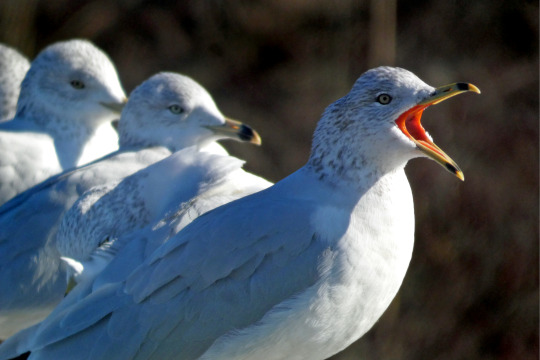
You don't have to yell about it
Ring-billed Gulls (Larus delawarensis)
December 15, 2023
John Heinz National Wildlife Refuge, Tinicum, Pennsylvania
#birds#bird#photographers on tumblr#gull#gulls#seagull#Larus delawarensis#birdblr#birb#birbs#ornithology#birblr#nature#animals#seagulls
232 notes
·
View notes
Photo
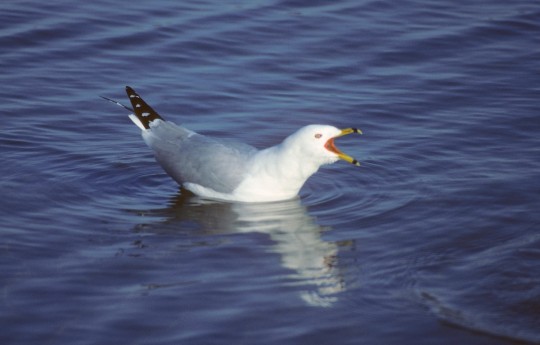
Ring-billed Gull (Larus delawarensis)
© Dave Spier
363 notes
·
View notes
Text





Sayreville to South Amboy
#ring billed gull#larus delawarensis#sanderling#brant#calidris alba#branta bernicla#middlesex county#new jersey#february#south amboy#sayreville#birds#raritan bay#bird watching#outdoors#hike#ken buchanan riverfront park#raritan bay county park#power plant#raritan bay waterfront park
11 notes
·
View notes
Text
If anything, homosexual females may be more hormonally "feminine" than heterosexual females: some lesbian Ring-billed Gulls actually have significantly higher levels of progesterone, a female hormone associated with nest-building and incubation behavior.
"Biological Exuberance: Animal Homosexuality and Natural Diversity" - Bruce Bagemihl
#book quote#biological exuberance#bruce bagemihl#nonfiction#homosexual#lesbian#hormones#feminine#ring billed gull#larus delawarensis#birds#gull#progesterone#nest building#incubation#animal behavior
2 notes
·
View notes
Text
There is an equally wide variation in the proportion of heterosexual, bisexual, and homosexual orientations among Ring-billed Gulls.
"Biological Exuberance: Animal Homosexuality and Natural Diversity" - Bruce Bagemihl
#book quote#biological exuberance#bruce bagemihl#nonfiction#variation#heterosexual#bisexual#homosexual#ring billed gull#larus delawarensis
0 notes
Text
Common Gulls are fairly sociable, often associating in flocks of up to 100 individuals; sometimes tens of thousands of birds congregate outside of the breeding season. Ring-billed Gulls are also gregarious.

"Biological Exuberance: Animal Homosexuality and Natural Diversity" - Bruce Bagemihl
#book quotes#biological exuberance#bruce bagemihl#nonfiction#ring billed gull#larus delawarensis#common gull#mew gull#larus canus#sociable#gregarious#breeding season
0 notes
Text
Let's all go to the party.
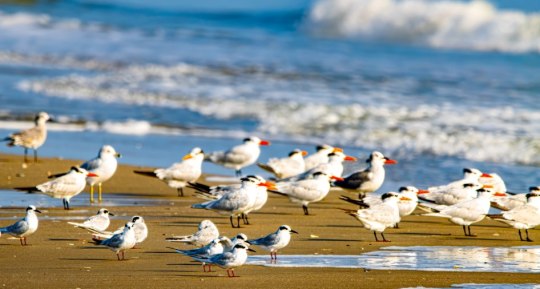
These are a bunch of royal terns (Thalasseus maximus), Forester's terns (Sterna forsteri), and ring billed gulls (Larus delawarensis). The focus is on the Forester's terns closer to the bottom of the frame. This was at Holly Beach, Louisiana.
"Flashing slender, silvery wings and an elegantly forked tail, Forster's Terns cruise above the shallow waters of marshes and coastlines looking for fish. These medium-sized white terns are often confused with the similar Common Tern, but Forster’s Terns have a longer tail and, in nonbreeding plumage, a distinctive black eye patch. Where Common breeds on outer beaches and barrier islands, Forster’s nests farther inland, on edges of freshwater marshes and saltmarshes. It is the only medium-sized tern species found in the United States mainland in winter." - allaboutbirds.org
#photography#photographer#photographylovers#bird#birdwatching#birdphotography#birds#birdsphotography#birds of north america#birdlovers#birdingphotography#birds nature#ring billed gull#forester's tern#royal tern
16 notes
·
View notes
Text
Round 1, Side B: Match 17


[Image ID: Two pictures of gulls. The left is a ring-billed gull standing on a wooden railing. The right is a Hartlaub's gull standing on a wooden railing. /End ID]
The ring-billed gull (Larus delawarensis) lives and breeds throughout North America. They typically measure 43-54 cm (17-21 in) in length and 105-117 cm (41-46 in) in wingspan. They have white underparts and head, light grey upperparts and wings with black and white tips, and yellow legs. Their name comes from their short yellow bill which has a dark band. They feed on fish, insects, worms, rodents, and grain, and steal food from other birds.
The Hartlaub's gull (Chroicocephalus hartlaubii) is a small gull found along the Atlantic coast of South Africa and Namibia. They typically measure 36-38 cm (14-15 in) in length. They have white underparts and head, pale grey upperparts and wings with black tips and white "mirrors," and dark red legs and bill. During the breeding season, they have a very faint lavender grey hood. They feed on fish, insects, invertebrates, and carrion.
ring-billed gull image by Ryan McGrady
Hartlaub's gull image by Lip Kee
8 notes
·
View notes
Text

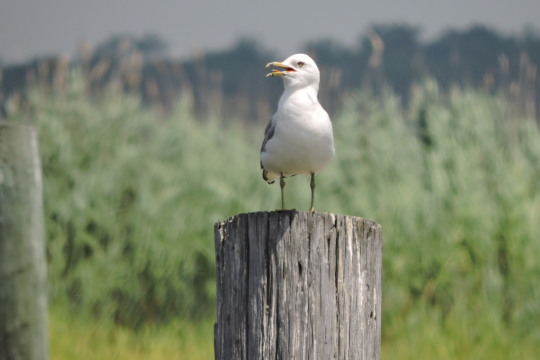
Ring-billed Gull, Larus delawarensis
3 notes
·
View notes
Text
[CM] Birds - Eyawoon
Onto the birds that ClayClan cats hunt! Eyawoon* are large birds that are difficult, but possible, to catch and kill. Most waterbirds fall into this category. Below are translations for several waterfowl, gulls, and a couple large land species.
The further I get into these posts, the less I have to say on specific species, sooo I’ll be adding some anecdotes from my real-world birding trips. Hopefully that’ll make the information more unique to read!
American wigeon (Mareca americana) - Rrawk
Duck with gray-brown feathers; males have a green stripe on the head. Present year-round but most common in winter, spring, and fall. Feed on aquatic and non-aquatic plants.
Wood duck (Aix sponsa) - Yyr’ip
Very distinctive species, males are elaborately marked. Present year-round but most abundant during warm months. Feed on plants and insects. Wood ducks are my favorite duck species!
Northern pintail (Anas acuta) - Brrip
Females resemble most ducks, but males have a clean brown head and long, pointed tail. Present only in spring and fall, during migration. Feed on plants. Considered by many to be a seasonal challenge!
Mallard (Anas platyrhynchos) - Kwek*
Our one other bird with a name from base Clanmew! The classic duck, males have a pretty green head. Abundantly present year-round. Feed on plants and small aquatic wildlife, like insects, tadpoles, worms, etc.
Herring gull (Larus argentatus) - Awah
A very familiar seagull with plain gray-and-white coloration, pink legs, and a clean yellow bill. Present year-round near the lake. Feed on a variety of fish, molluscs, insects, and more. Some superstitious cats refuse to eat or hunt gulls due to stories conflating them with Yiaow through the ocean, where they’re rumored to gather in vast flocks.
Ring-billed gull (Larus delawarensis) - Ha’ah
Very similar to herring gulls, distinguished by their yellow legs and striped bill. Present year-round near the lake, more common than herring gulls. Feed on insects, fish, rodents, and more. Ring-billed gulls have the same ocean association as herring gulls.
Spruce grouse (Falcipennis canadensis) - Shafoo
Brown, chickenlike birds with mottled feathers. Present rarely in the forest during summer. Feed mostly on pine needles.
American coot (Fulica americana) - Rroonk
Black duck-like waterbird with big gray feet. Present rarely in the winter. Feed on plants. Rroonk is among my favorite Claymew words - it always seems to give me echolalia.
Double-crested cormorant (Phalacrocorax auritus) - Rru
Large black bird with a long, snakelike neck, often seen with its wings spread in the sun. Present year-round, but most abundant in spring, summer, and fall. Feed mostly on fish. Cormorants are a favorite bird of mine, I love seeing them sun themselves (I also think their calls sound like clacking wood).
Adult male wild turkey (Meleagris gallopavo) - Gablgabl
Adult female wild turkey (Meleagris gallopavo) - Kluk
Wild turkey chick (Meleagris gallopavo) - Twee
The truest eyawoon* of them all - adult turkeys are very difficult to hunt, given their huge size and communal nature, but when caught they make for a feast. If they weren’t edible, turkeys would be considered yassga* for their aggression in the fall. Present year-round. Feed on plants, insects, worms, and other small foraged things.
Green heron (Butorides virescens) - Ekchee
Dark heron with bright yellow legs; its feathers are more colorful when seen up close. Present in late spring, summer, and fall. Feed mostly on small fish.
3 notes
·
View notes
Text
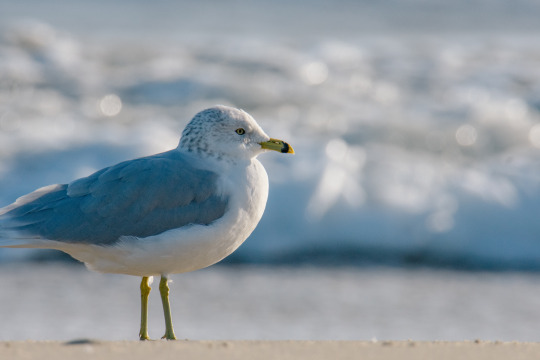
ring-billed gull | Larus delawarensis
2 notes
·
View notes
Photo

Ring-Billed Gull
Larus delawarensis
Laridae
Photograph taken on October 11, 2021, at Rattray Marsh Conservation Area, Mississauga, Ontario, Canada.
2 notes
·
View notes
Text
Estimating bird populations can be challenging due to the vast ranges many species cover and fluctuations in their numbers over time. However, certain species stand out for their significant population sizes. Here's a look at some of the most populous bird species and details about each, including their habitats and locations. This list is not exhaustive or ranked precisely by population size, as comprehensive and current global counts for all species are difficult to obtain.
1. **House Sparrow (Passer domesticus)**
- Population: Estimated in the hundreds of millions globally.
- Location: Originally from Europe and Asia, now found worldwide except for polar regions.
- Details: Adapts well to urban environments, often found near human settlements.
2. **European Starling (Sturnus vulgaris)**
- Population: Over 200 million.
- Location: Native to Eurasia, widely introduced elsewhere, including North America and Australia.
- Details: Known for their stunning murmurations and ability to mimic sounds.
3. **Ring-billed Gull (Larus delawarensis)**
- Population: Tens of millions.
- Location: North America, especially in the Great Lakes, the Northeastern U.S., and Canada.
- Details: Common in both freshwater and coastal regions, easily recognizable by the black ring around its bill.
4. **Red-billed Quelea (Quelea quelea)**
- Population: Estimated at 1.5 billion.
- Location: Sub-Saharan Africa.
- Details: Often considered the most numerous wild bird on earth, a significant pest for grain crops.
5. **Mourning Dove (Zenaida macroura)**
- Population: Estimated 475 million.
- Location: North and Central America.
- Details: Known for its mournful cooing, these birds are popular among hunters.
6. **American Robin (Turdus migratorius)**
- Population: Estimated 310 million.
- Location: Throughout North America.
- Details: Recognizable by their bright red chest, they are a common sight in gardens.
7. **Barn Swallow (Hirundo rustica)**
- Population: Estimated at 190 million.
- Location: Found in Europe, Asia, Africa, and the Americas during their respective summer seasons.
- Details: Known for their long forked tails and acrobatic flight, they feed on insects caught in flight.
8. **Snow Goose (Anser caerulescens)**
- Population: Several million.
- Location: North America, breeding in Canada and wintering in the southern U.S. and Mexico.
- Details: Noted for their white plumage and black wingtips, they migrate in large, noisy flocks.
9. **Mallard (Anas platyrhynchos)**
- Population: Estimated 19 million in North America alone.
- Location: Native to temperate and subtropical Americas, Europe, Asia, and North Africa.
- Details: The most familiar wild duck, the ancestor of most domestic ducks.
10. **Canada Goose (Branta canadensis)**
- Population: Estimated over 5 million.
- Location: North America, with some populations in Northern Europe.
- Details: Known for their seasonal migrations, recognizable by their black head and neck with a white chinstrap.
11. **Common Coot (Fulica atra)**
- Population: Millions globally.
- Location: Found across much of the Old World and parts of the New World.
- Details: Aquatic birds known for their distinctive white beak and forehead, they are more related to rails than ducks.
12. **Rock Pigeon (Columba livia)**
- Population: Estimated in the hundreds of millions worldwide.
- Location: Originally native to Europe, North Africa, and South Asia, now found in cities worldwide.
- Details: Often considered pests, they have adapted well to urban environments.
13. **Common Myna (Acridotheres tristis)**
- Population: Tens of millions.
- Location: Native to Asia, introduced in many other parts of the world.
- Details: Known for their ability to mimic sounds, these birds thrive in urban areas.
14. **European Herring Gull (Larus argentatus)**
- Population: Several million.
- Location: Europe and Western Asia, with populations in North America.
- Details: Large, noisy seabirds, they are versatile feeders.
15. **Common Swift (Apus apus)**
- Population: Tens of millions.
- Location: Europe and Asia, wintering in Africa.
- Details: Spend most of their life flying, eating, and even sleeping on the wing.
16. **Red-winged Blackbird (Agelaius phoeniceus)**
- Population: Estimated over 100 million.
- Location: North and Central America.
- Details: The males are identifiable by their bright red shoulder patches.
17. **Northern Pintail (Anas acuta)**
- Population: Millions.
- Location: Breeds in the northern areas of Europe, Asia, and North America.
- Details: Elegant ducks, males have a distinctive long tail.
18. **Great Tit (Parus major)**
- Population: Tens of millions.
- Location: Europe, Middle East, Central and Northern Asia.
- Details: Adaptable and common in woodlands as well as urban gardens, known for their vibrant yellow and black coloring.
19. **Eurasian Collared-Dove (Streptopelia decaocto)**
- Population: Millions.
- Location: Native to Asia and Europe, has rapidly spread across North America.
- Details: Recognizable by their collar-like marking, they have a distinctive cooing call.
20. **Cattle Egret (Bubulcus ibis)**
- Population: Several million.
- Location: Found in warm climates across the world, including the Americas, Africa, Asia, and Australia.
- Details: Adapted to live among cattle and other large mammals, feeding on insects disturbed by these animals.
These populations are subject to change due to environmental factors, conservation efforts, and changing habitats. The locations provided reflect the broad distribution of these species, which can vary widely within the ranges mentioned.

0 notes
Text
Ring Billed Gulls have Forward and Interesting Personalities
Ring Around the Bill
Another bird that I ran into in Cedar Key last week was this very outgoing adult ring billed gull (Larus delawarensis). Although the brown pelicans were in the process of molting into their breeding plumage, this guy was still sporting his winter attire. Ring billed gulls are winter visitors here in Florida and head north into Canada and the very northernmost parts of the…

View On WordPress
#avians#bird photographs#bird photography#birds#coastal birds#coastal birds of Florida#Florida birds#Florida gulls#Florida sea gulls#Florida winter birds#Florida winter gulls#grey and white sea gulls#gull photographs#ring billed gulls#sea gull photographs#sea gulls#wildlife#wildlife photographs#wildlife photography#winter birds#winter gulls
0 notes
Text
In other colonies, egg fertility of female pairs is much higher – two-thirds to nearly 90 percent – indicating a greater prevalence of bisexual activity.
"Biological Exuberance: Animal Homosexuality and Natural Diversity" - Bruce Bagemihl
#book quote#biological exuberance#bruce bagemihl#nonfiction#ring billed gull#larus delawarensis#eggs#fertility#bisexual
0 notes
Photo

Big yawn! Boring!... Ring-billed gull / Goéland à bec cerclé / Larus delawarensis #RingBilledGull #GoélandÀBecCerclé #LarusDelawarensis #BirdsOfGeorgia #Birding #BirdPhotography #ColonialCoastBirdingTrail #GeorgiaBirdingTrails #JekyllIsland #Brunswick (at Jekyll Island) https://www.instagram.com/p/CnLGlueOsdn/?igshid=NGJjMDIxMWI=
#ringbilledgull#goélandàbeccerclé#larusdelawarensis#birdsofgeorgia#birding#birdphotography#colonialcoastbirdingtrail#georgiabirdingtrails#jekyllisland#brunswick
0 notes